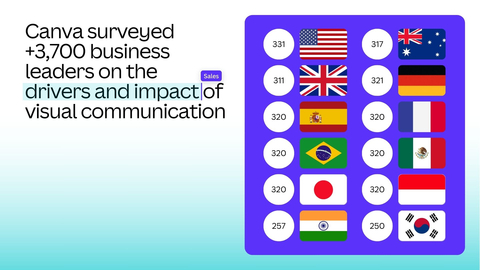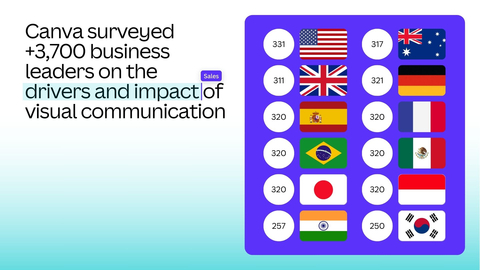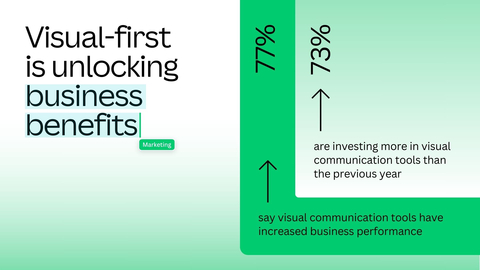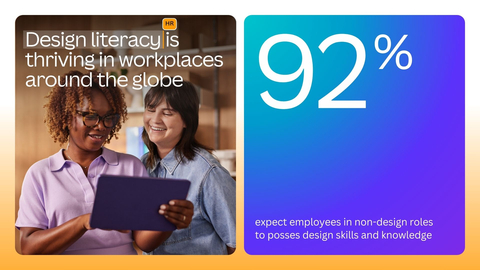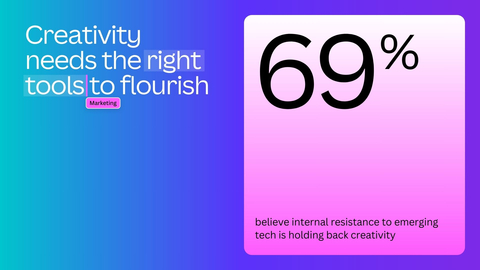SAN FRANCISCO--(BUSINESS WIRE)--Canva, the world’s only all-in-one visual communication platform, today released its second annual Visual Economy Report featuring insights from more than 3,700 global business leaders on the drivers and impact of visual communication.
The company commissioned business intelligence firm Morning Consult to understand how they're approaching the use of visual communications tools in the workplace and the role AI is playing in their ability to increase productivity, elevate creativity, and streamline workflows. The survey was conducted in 12 markets, including the US, UK, France, Germany, Spain, Brazil, Mexico, India, Indonesia, Japan, South Korea, and Australia.
The top global findings include:
-
Unlocking business benefits:
More than three-quarters (77%) say visual communication tools have increased business performance. From accelerating content creation and team collaboration to stronger audience engagement, visual-first communication is supercharging how organizations save time and money. As a result, 73% of leaders are investing more in visual communication tools than the previous year.
-
AI fast tracks productivity:
Tighter budgets and increased content demands have led more than three-quarters (82%) of leaders to explore AI-powered tools as options to accelerate their content production needs. The vast majority (90%) agree the quality of visual content has improved because of AI, yet concerns about plagiarism (70%), bias (68%), and job loss (64%) linger.
-
Design democratized:
The ability to communicate visually is now table stakes in the workplace, regardless of role. The majority of leaders (92%) expect employees in non-design roles to possess some design acumen in order to be effective communicators in their organizations. Consequently, more than two-thirds (68%) are now providing training to those not in design roles to meet a certain threshold of design competency.
-
Accelerating scaling through collaboration:
Nearly one-third (30%) believe the inability to collaborate across teams and complex workflows (28%) is a challenge when creating and scaling content. As a result, when investing in visual communication platforms, business leaders are emphasizing real-time collaboration (93%), more streamlined workflows (93%), and all-in-one functionality (92%).
-
Creativity needs the right tools to flourish:
Over three-quarters (69%) believe senior stakeholder resistance to new technology is hindering creativity in the workplace. Sixty-five percent attribute siloed teams and poor cross-functional collaboration as deterrents to imaginative thinking and fresh outputs.
From compelling presentations to engaging videos and interactive data visualizations, visuals have become the currency of communication, enabling organizations to cut through the noise.
“We use Canva for just about anything that is templatized, from presentations to digital signage, internal websites, invitations, playbooks – the possibilities are endless. The ability to easily collaborate and share designs across so many teams has been a huge timesaver. What would normally take days can take only minutes,” said Rebecca Janes, Creative Designer and Environmental Branding Strategist, FedEx Global Brand.
The need to communicate visually, internally and externally, is fuelling organization-wide demand for easy-to-use and interoperable visual communication tools. The convergence of AI and visual communication has also opened up endless possibilities for all professionals to create high-impact content and to do so at scale.
"Communicating visually has always been humanity's most powerful medium, and it's even more important in the digital age – bridging workplaces and captivating audiences like never before. It's emerging as the currency of true connection,” said Cameron Adams, co-founder and chief product Officer, Canva. “Harnessing the power of visuals and enhancing them with AI capabilities isn’t just beneficial to team communication, it is now a crucial advantage for leaders in their quest to hire, market and sell while aiming to get better results on their financial investments.”
The Visual Economy Report 2024 surveys 3,707 business leaders in marketing, sales, human resources, and operations who have knowledge of company revenue goals. This group also influences their organizations’ audience engagement strategy and how internal teams communicate with each other, other teams, and the company at large.
Specifically, Canva surveyed 331 business leaders (Director+, VP+, C-Suite+) in the US, 317 in Australia, 311 in the UK, 321 in Germany, 320 in Spain, 320 in France, 320 in Brazil, 320 in Mexico, 320 in Japan, 320 in Indonesia, 257 in India and 250 in South Korea.
Access Canva’s “The Visual Economy Report 2024” here.
About Canva
Launched in 2013, Canva is a free online visual communications and collaboration platform with a mission to empower everyone in the world to design. Featuring a simple drag-and-drop user interface and a vast range of templates ranging from presentations, documents, websites, social media graphics, posters, apparel to videos, plus a huge library of fonts, stock photography, illustrations, video footage, and audio clips, anyone can take an idea and create something beautiful.

